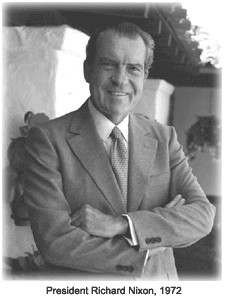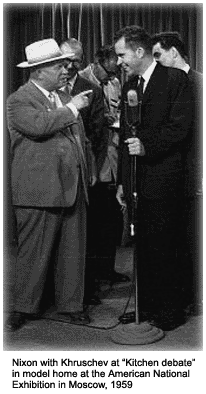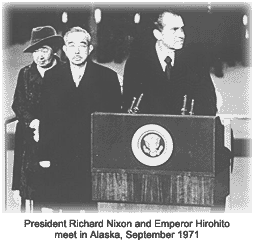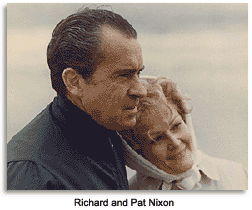Richard M. Nixon was one of the two most successful national politicians in American history. He won four national elections, twice for the vice presidency and twice for the presidency. Only Franklin D. Roosevelt won as many national elections as Nixon. Nevertheless, despite a six-year term, save several achievements — particularly in foreign affairs — Nixon will always be remembered for the scandal that forced his resignation: Watergate.
 Early years
Early years
Richard Milhous Nixon was born on January 9, 1913, in Yorba Linda, California, a small community located 30 miles southeast of Los Angeles. His parents, Francis and Hanna Nixon, had five sons, of which Richard was the second. Nixon`s mother had been reared as a Quaker and his father abandoned his Methodist faith after their marriage and became a Quaker as well. Nixon was educated in public schools in Yorba Linda and Whittier, where the family moved when he was nine. After high school, Nixon enrolled at Whittier College, a Quaker institution, where he was a successful student politician, becoming president of the student body. After Whittier, Nixon attended Duke University Law School, where he graduated third of the 44 members of the class of 1937.
After law school, Nixon returned to Whittier and joined a law firm, in which he soon became a partner. About this time, he met Patricia Ryan, whom he married on June 21, 1940. Nixon joined the Navy at the outbreak of World War II and rose to the rank of lieutenant commander by the end of the conflict.
Political rise
After the war, Republicans in Nixon`s home congressional district were looking for an attractive candidate to run against long-time incumbent Jerry Voorhies. Nixon ran a strong campaign and showed considerable skills in a public debate against Voorhies. He was elected in 1946 and re-elected in 1948 without opposition in the general election.
In Washington, Nixon joined the House Committee on Un-American Activities and was one of the most persistent interrogators of Alger Hiss when he appeared before the committee. His performance on the committee brought him national attention that led to his nomination by the Republican Party to run against U.S. Senator Helen Gahagan Douglas in 1950. Using dubious allegations about her attitude towards communism, Nixon won the election by nearly 700,000 votes.
In 1952, the Republicans nominated Nixon to run with Dwight D. Eisenhower on their national slate. Nixon again used the techniques that had worked for him in the past, describing the Democratic nominee Adlai E. Stevenson as having a "Ph.D. from Dean Acheson`s cowardly college of communist containment," referring to Truman`s Secretary of State Dean Acheson at that time.
During the campaign, allegations arose about money that a few political supporters had provided Nixon, that Democrats alleged was a "secret slush fund" that he had used to upgrade his lifestyle. Nixon appeared on national television and radio to defend himself. He asserted that his wife had no fur coat, only a "respectable Republican cloth coat," and that although their dog Checkers had been a gift to his children, they were not giving it up. The broadcast, which became known as the “Checkers Speech,” met with great public approval that resulted in a landslide victory for Eisenhower and Nixon. At their next meeting, Eisenhower told Nixon, "You`re my boy."
In the new administration, the youthful Nixon was given more responsibility than previous vice presidents. His skills were tested in September 1955, after Eisenhower suffered a heart attack. Nixon`s performance then, and during Eisenhower`s later illnesses in 1956 and 1957, helped build his reputation for competence.
 Not all Republicans were enchanted with him, however, and in 1956, Harold E. Stassen took a leave from the Eisenhower Administration to devote considerable energy in an attempt to prevent Nixon’s re-nomination. The party rebuffed him and Nixon was not only re-nominated but also re-elected. During Eisenhower`s second term, Nixon traveled around the world representing the United States. In July 1959, at an exhibit showcasing a General Electric model kitchen, at the U.S. Trade and Cultural Fair in Moscow, he was joined by Soviet Premier Nikita Khrushchev, with whom he had a widely reported "kitchen debate" about the merits of their respective political regimes. The perception that Nixon was someone who could "stand up" to the Soviets enhanced his status as an experienced and effective statesman.
Not all Republicans were enchanted with him, however, and in 1956, Harold E. Stassen took a leave from the Eisenhower Administration to devote considerable energy in an attempt to prevent Nixon’s re-nomination. The party rebuffed him and Nixon was not only re-nominated but also re-elected. During Eisenhower`s second term, Nixon traveled around the world representing the United States. In July 1959, at an exhibit showcasing a General Electric model kitchen, at the U.S. Trade and Cultural Fair in Moscow, he was joined by Soviet Premier Nikita Khrushchev, with whom he had a widely reported "kitchen debate" about the merits of their respective political regimes. The perception that Nixon was someone who could "stand up" to the Soviets enhanced his status as an experienced and effective statesman.
Nixon ran for the Republican presidential nomination and won it with little opposition. Henry Cabot Lodge Jr. was added as the vice-presidential nominee to oppose John F. Kennedy and Lyndon B. Johnson. The initial advantage appeared to be with Nixon, but Kennedy managed to defuse the anti-Catholic issue (he was Catholic) and performed well during his televised debates with Nixon. In November, Kennedy won in the closest election since 1884. It is possible that Kennedy`s margin in the Electoral College was the result of voter fraud in Illinois and Texas, but Nixon did not contest the outcome.
Nixon returned to California, where he began to practice law again. In an attempt to revive his political fortunes, he ran for governor in 1962. A bruising primary against a candidate favored by the Republican right wing split the party, and in November, Nixon lost again. So frustrated was he by the perceived bias against him by the press, that he rebuked the press for their coverage on the morning after his loss and ended, famously, by saying, "You won`t have Dick Nixon to kick around anymore because, gentlemen, this is my last press conference."
It wasn`t, of course. In 1964, Nixon resisted the temptation to run against Barry Goldwater, who seemed to have captured the devotion of many of the party`s most faithful members. The results in November 1964, were disastrous at all levels for Republicans and in its bitter aftermath, Richard Nixon was the only national leader with appeal for both wings. During the 1966 campaign, Nixon worked hard for Republican candidates throughout the country and was given a great deal of credit for the Republican recovery in the elections.
Nixon declared his candidacy for the Republican presidential nomination in February 1968, and easily carried the primaries against Nelson Rockefeller and Ronald Reagan. After winning the nomination on the first ballot at the convention, Nixon chose Maryland governor Spiro Agnew as his running mate. They faced a Democratic Party deeply divided by the Vietnam War and defeated Hubert Humphrey and Edmund Muskie by 800,000 popular votes and by 301 to 191 in the Electoral College.
Presidency
Nixon faced broad and deep challenges at home and abroad during his presidency. One of his first proposals as president was for a dramatic restructuring of the U.S. government to trim the fat of federal bureaucracies and return certain controls back to the states and municipalities. Under his 1969 plan called “New Federalism,” a government restructuring would free creative entrepreneurship from mounds of federal government red tape and discourage a dependency on handouts from the federal government. By directing power and money away from federal bureaucracies, the plan would more effectively handle people’s needs within their own states and municipalities. Although there was much opposition to Nixon’s plan, (especially from within the deeply entrenched Federal bureaucracy), elements of it, (New Federalism), were used for the desegregation of schools and for furthering the rights of women.
Racial tensions had broken out in destructive riots in Los Angeles, Detroit, and other cities. Nixon was forced to balance the legitimate concerns of black Americans with the desire of many white Americans for a return to "law and order." The Kent State shootings, on May 4, 1970, during a violent anti-war student demonstration on the campus of Kent State University in Ohio drew international attention and further stressed the embattled president and shook his administration.
Inflation also was on the rise and Nixon attempted to curb it with wage and Price Controls in August 1971. The strategy was to freeze wages and prices for 90 days, followed by a transition to controlled changes. The policy seemed to work at first and was warmly accepted by the stock market, but eventually proved to be unworkable and was abandoned in April 1974. The economy slid into recession in 1974 when inflation climbed to 12.1 percent after the onset of the Arab oil boycott in October 1973.
 In foreign affairs, the United States faced ongoing generalized challenges from the two main communist powers, the Soviet Union and China, as well as a specific problem in Vietnam. Nixon proved more successful at dealing with the former. In 1971, he made overtures to the Chinese, which resulted in his trip to Peking (now Beijing) in February 1972. The Soviets, mindful of the possibility that the United States would ally itself with its rival, became more agreeable and soon established a period of Detente between the Soviet Union and the United States. The Vietnam issue was not as easily resolved. Nixon alternately tried to cajole and coerce the North Vietnamese into negotiations, but they held firm to their goal of a Vietnam united under their control. Eventually, Nixon`s secretary of state, Henry Kissinger, negotiated a withdrawal of American troops that resulted in the collapse of the American-backed regime in the south in 1975.
In foreign affairs, the United States faced ongoing generalized challenges from the two main communist powers, the Soviet Union and China, as well as a specific problem in Vietnam. Nixon proved more successful at dealing with the former. In 1971, he made overtures to the Chinese, which resulted in his trip to Peking (now Beijing) in February 1972. The Soviets, mindful of the possibility that the United States would ally itself with its rival, became more agreeable and soon established a period of Detente between the Soviet Union and the United States. The Vietnam issue was not as easily resolved. Nixon alternately tried to cajole and coerce the North Vietnamese into negotiations, but they held firm to their goal of a Vietnam united under their control. Eventually, Nixon`s secretary of state, Henry Kissinger, negotiated a withdrawal of American troops that resulted in the collapse of the American-backed regime in the south in 1975.
The Democrats gave their nomination in 1972 to Senator ^George McGovern^ of South Dakota, whose views were so far to the left that many Democrats were alienated. Nixon`s re-election was never seriously in doubt, but in an attempt to guarantee it, he allowed people associated with his campaign to burglarize the offices of the Democratic National Committee at the Watergate apartments in Washington, D.C. He then compounded the crime by attempting to cover it up. The slowly unfolding scandal eventually engulfed his administration.
While that was happening, however, a faster-moving scandal developed around Spiro Agnew, who was indicted of corruption and resigned as vice president to avoid prosecution. Under the terms defined by the Twentieth Amendment to the U.S. Constitution, it was necessary to appoint a new vice president and Gerald R. Ford was given that position.
Resignation
As Watergate revelations became harder to ignore, the Congress began to investigate. It soon became clear that Nixon had been personally involved to such an extent that impeachment and conviction were likely. Nixon accepted the inevitable and announced on August 8, 1974, that he was resigning, effective noon on the following day to begin "that process of healing which is so desperately needed in America." As vice-president, Gerald R. Ford was sworn in as Nixon`s successor and on September 8, 1974, announced that Nixon was being pardoned for all crimes that he might have committed during his presidency, thereby ending any threat of prosecution. That decision was met with sharp controversy, but it prevailed.
Nixon resigned from the presidency at the height of the most contentious and unstable era in American history since the Civil War. The U.S. economy was floundering with lengthening gas lines, rising unemployment and inflation, and the stock market dropping.
 In subsequent years, Nixon attempted to rehabilitate his image by representing himself as an elder statesman and by writing several books, including: The Real War (1980); Leaders (1982); Real Peace (1983); No More Vietnams (1985); 1999: Victory without War (1988); In the Arena (1990); Seize the Moment (1992); and Beyond Peace (1994). None of this ameliorated the effects of Watergate, which continued to haunt him until his death on April 22, 1994. His wife Pat had died the previous year, after more than 50 years of marriage.
In subsequent years, Nixon attempted to rehabilitate his image by representing himself as an elder statesman and by writing several books, including: The Real War (1980); Leaders (1982); Real Peace (1983); No More Vietnams (1985); 1999: Victory without War (1988); In the Arena (1990); Seize the Moment (1992); and Beyond Peace (1994). None of this ameliorated the effects of Watergate, which continued to haunt him until his death on April 22, 1994. His wife Pat had died the previous year, after more than 50 years of marriage.